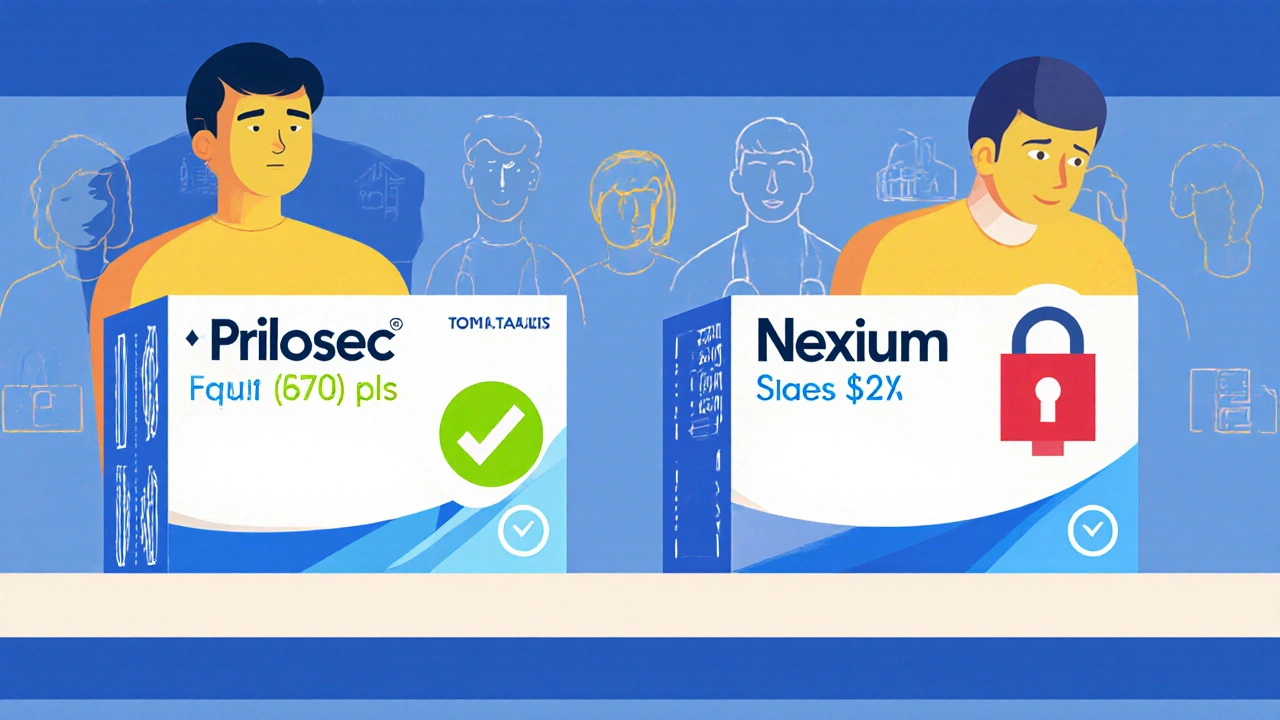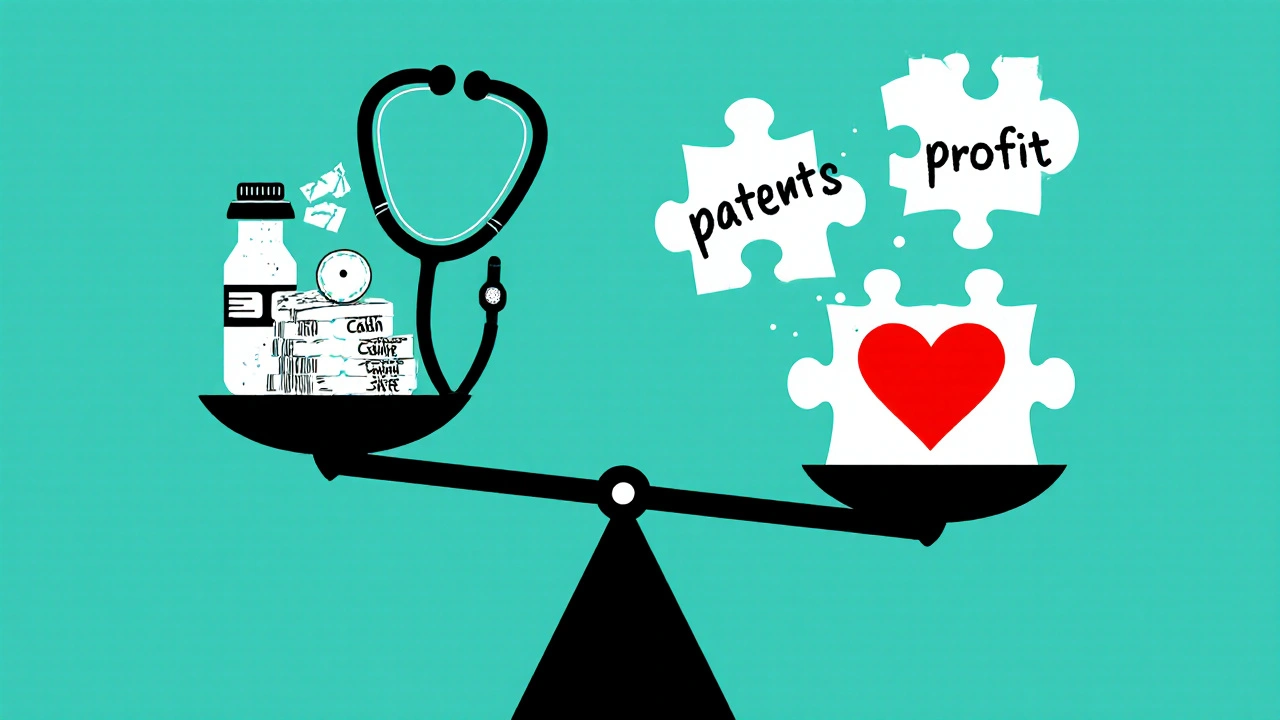Imagine a drug that saves lives - but costs $10,000 a month. Now imagine that same drug could cost $200 if generics were allowed in. That’s the reality created by evergreening, a legal strategy used by big pharmaceutical companies to keep prices high by stretching out patent protection long after the original invention has run its course.
What Evergreening Really Means
Evergreening isn’t about inventing new medicine. It’s about tweaking old ones just enough to file a new patent. Think of it like changing the color of a car and calling it a new model. The engine? Same. The performance? Same. But now, the company gets another 20 years of monopoly pricing.
The U.S. Hatch-Waxman Act of 1984 was meant to balance innovation with access. It gave drug makers 20 years of patent protection, then opened the door for cheaper generics. But companies quickly learned how to game the system. Instead of developing breakthrough drugs, they started filing dozens of patents on minor changes: a new pill coating, a slightly different dose, a delayed-release version, or even a new combination with another drug already on the market.
These aren’t innovations that help patients. They’re legal maneuvers designed to delay competition. According to research from Harvard, nearly 78% of new patents on prescription drugs are for existing medications - not new ones. That’s not progress. That’s padding.
How It Works: The Playbook
Here’s how evergreening plays out in real life:
- Product hopping: A company stops selling the original drug and pushes patients to a new version - say, switching from Prilosec to Nexium. The new version isn’t better, just patented. Patients are forced to pay more, and pharmacies can’t substitute generics.
- Patent thickets: One drug gets dozens of patents. AbbVie filed 247 patents on Humira, a drug for autoimmune diseases. Over 100 were granted. This creates a legal maze. Generic makers can’t risk suing on all fronts - the cost is too high, and the risk of losing is too great.
- Orphan drug and pediatric extensions: If a company tests a drug on children or rare diseases, they get extra exclusivity. Sometimes, they run small trials just to trigger these extensions - not because it helps patients, but because it buys time.
- Authorized generics: The brand company launches its own generic version at a lower price. This scares off real generic makers who can’t compete with the original brand’s pricing power. It looks like competition, but it’s not.
- OTC switching: A drug is taken off prescription and sold over-the-counter. This resets the clock on exclusivity because it’s now classified as a new product, even if it’s the exact same pill.
These tactics aren’t rare. They’re standard. AstraZeneca extended patent life on six top-selling drugs by more than 90 years combined. Humira, one of the most profitable drugs in history, made $40 million a day for AbbVie thanks to patent stacking. That’s not luck. That’s strategy.
Why It Hurts Patients
When generics enter the market, prices drop by 80% to 85% within the first year. That’s not speculation - it’s proven. But evergreening blocks that drop. And the cost isn’t just financial.
People with chronic conditions like rheumatoid arthritis, Crohn’s disease, or diabetes are forced to choose between paying thousands for a brand drug or skipping doses. In the U.S., one in four adults report skipping medication because of cost. In Australia, where drug prices are lower thanks to the PBS, patients still face delays when generics are held back by patent tricks.
And it’s not just the U.S. The World Health Organization called evergreening a major barrier to affordable medicines in low- and middle-income countries. A drug that costs $100 a month in the U.S. might cost $10 in India - if generics can get through the patent wall.
Patients don’t benefit from these tweaks. The new version of the drug usually offers no clinical advantage. Studies show Nexium isn’t more effective than Prilosec. Humira’s new formulations don’t work better than the original. The only thing that changed? The price tag.

Who’s Fighting Back?
Regulators and courts are starting to push back.
In 2022, the U.S. Federal Trade Commission sued AbbVie over Humira’s patent strategy, calling it an anticompetitive scheme. The FTC argued that the 247 patents were a deliberate effort to stifle competition, not protect innovation. The case is still ongoing, but it’s a signal: regulators are watching.
The Inflation Reduction Act of 2022 gave Medicare the power to negotiate prices for high-cost drugs. That’s a direct threat to evergreening. If the government can cap the price of a drug, the incentive to stretch patents weakens.
Europe is stricter. The European Medicines Agency now requires proof of “significant clinical benefit” before granting extra exclusivity for modified drugs. That’s a big deal. It means companies can’t just file a patent for a new pill shape - they have to prove it helps patients more.
Even the U.S. Patent Office is getting tougher. They’re rejecting obviousness-type double patents - where a company tries to patent something that’s just a minor variation of an earlier patent. But the system is still slow, and companies have armies of lawyers.
The Bigger Picture: Innovation vs. Profit
Developing a brand-new drug takes 10 to 15 years and costs $2.6 billion on average. That’s real science. Real risk. Real reward.
Evergreening? It costs a fraction of that. A new formulation might take a year and a few million dollars. The return? Billions. And no clinical risk.
So what’s the incentive? Not innovation. It’s profit. And the system is built to reward it.
Some argue that evergreening helps fund future research. But the numbers don’t add up. The money spent on patent thickets and marketing tweaks far outweighs what’s spent on actual R&D for new molecules. Companies aren’t reinvesting savings into breakthroughs - they’re reinvesting in more patents.
The real innovation isn’t in changing pill coatings. It’s in finding new ways to treat cancer, Alzheimer’s, or antibiotic-resistant infections. Those are the areas where funding is falling short - not because of lack of need, but because the profit model is broken.

What Can Be Done?
There’s no single fix, but progress is possible:
- Stricter patent standards: The USPTO needs to reject patents that offer no real therapeutic improvement.
- Transparency: All patent filings related to a single drug should be publicly tracked and flagged for review.
- Fast-track generic approval: If a drug’s original patent expires, generics should be allowed in immediately unless there’s a legitimate, court-validated reason to delay.
- Price negotiation: Governments need the power to set fair prices - especially for drugs with no real innovation behind them.
- Public pressure: Patients and advocates need to call out cases like Humira and Nexium. When the public understands how the system is rigged, change follows.
It’s not about stopping innovation. It’s about stopping exploitation.
What’s Next?
Companies are already moving to the next frontier: biologics, nanotech, and pharmacogenomics. These are complex drugs - harder to copy. That means the next wave of evergreening might involve patenting genetic tests that predict who responds to a drug - then blocking generics from using that data.
It’s the same game, just with more science behind it.
The question isn’t whether evergreening will continue. It’s whether society will let it.
Is evergreening illegal?
No, evergreening isn’t illegal - it’s legal but controversial. Companies use existing patent laws to file for extensions on minor changes. The problem isn’t the law itself, but how it’s exploited. Courts and regulators are starting to challenge these tactics, but they’re still allowed under current rules.
Do evergreened drugs work better than generics?
Almost always, no. Studies show that drugs like Nexium and new versions of Humira offer no meaningful clinical benefit over the original. The changes are usually in dosage form, coating, or timing - not effectiveness. Patients get the same result, but pay much more.
How long does a drug patent last?
The standard patent lasts 20 years from the filing date. But because drug development takes years, companies often get only 7-12 years of market exclusivity after approval. Evergreening adds extra years through new patents, pediatric extensions, orphan drug status, and other loopholes - sometimes extending total exclusivity by decades.
Why don’t generic companies challenge these patents?
Because it’s too expensive and risky. When a company files 100+ patents on one drug - like AbbVie did with Humira - generic makers face a legal minefield. Challenging one patent might cost millions, and if they lose, they’re stuck. Many choose not to fight at all, even if the patents are weak.
Can I tell if a drug is affected by evergreening?
Yes. If the drug you’re taking has a very recent version with a slightly different name - like "Xr" or "Extended Release" - and it’s much more expensive than the original, it’s likely an evergreened version. Check the FDA’s Orange Book or ask your pharmacist. If the active ingredient hasn’t changed, but the price jumped, that’s a red flag.
Are there any drugs that escaped evergreening?
Yes. Many older, simple drugs like metformin, lisinopril, and simvastatin never had complex patent strategies. They’re still affordable because their patents expired cleanly. But these are the exceptions. Most blockbuster drugs today - especially those for chronic conditions - have been heavily evergreened.
Final Thought: Who Pays the Price?
Every time a company extends a patent by five years with a minor tweak, someone else pays. A diabetic skipping insulin. A cancer patient delaying treatment. A family choosing between medicine and rent.
Evergreening isn’t just a corporate tactic. It’s a public health issue. And until we fix the rules, the system will keep rewarding the same old tricks - not real cures.


Kristi Joy
My dad’s on Humira and he’s been paying $1,200 a month for years. When we found out the generic could’ve been $150, we were devastated. He didn’t even know the drug hadn’t changed - just the price. I wish more people understood this isn’t about innovation, it’s about greed wrapped in legal jargon.
Pharma reps come to his clinic all the time, pushing the new version like it’s magic. No one ever mentions the original exists. It’s manipulation, plain and simple.